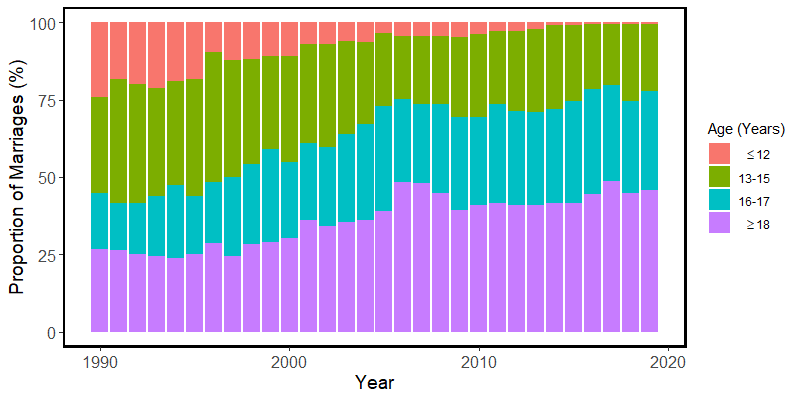Remembering children on Human Rights Day
Today, we celebrate the anniversary of the Universal Declaration of Human Rights. Since its adoption by the United Nations General Assembly in 1948, we have made immense strides in realising and protecting these inalienable rights and freedoms.
As we celebrate these important achievements, we should also pause to consider where we have fallen short. One example is child marriage, a major human rights violation that can result in social, psychological, and physical harms.
Although an estimated 25 million child marriages have been prevented in the last decade, at the current rate of decline, it will take at least another century to end child marriage – decades after the 2030 target described in WHO SDG goal 5.
59% of women in Bangladesh are married before 18
Recent global estimates among women 20–24 years of age show 21% were married before they turned 18, with child marriage most prevalent in Sub-Saharan Africa and South Asia.
In Bangladesh, 59% of women 20–24 years of age were married before they turned 18 and 22% were married before the age of 15.
The Government of Bangladesh is committed to ending child marriage; however, the practice remains common in the country.
Threat of child marriage to health
The Child Health and Mortality Prevention Surveillance (CHAMPS) network aims to identify causes of death among children under 5 years in areas of Sub-Saharan Africa and South Asia.
As one of seven CHAMPS sites, CHAMPS Bangladesh is interested in child marriage because it threatens the health of two groups of children: young mothers and their newborns.
In 2017, we started a demographic surveillance system (DSS) in Baliakandi, a rural subdistrict of Bangladesh, which captures sociodemographic data for 220,000 residents, including marriage histories and prospective identification of marriages, pregnancies, births and deaths.
Our surveillance and data collection efforts have shown that the vast majority of under 5 child deaths in Baliakandi are stillbirths or early neonatal deaths (death in the first week of life) (Figure 1).
Figure 1. Age distribution of recorded under 5 child deaths (n=384) in Baliakandi subdistrict*, Bangladesh, September 2017 to June 2019
 Progress in reducing child marriage has stalled
Progress in reducing child marriage has stalled
Child marriage prevalence in rural Bangladesh has dropped substantially from 1990 to 2006, but little has changed since then.
Using data from the DSS, we investigated the temporal trends in the proportion of marriages to child brides, and the average age at marriage (Figure 2).
Between 1990 and 2006, the prevalence of child marriage dropped substantially from 73% to 52% and the average age at marriage increased from 15.2 to 17.4 years.
This decline was largely due to fewer marriages to children under 13 years of age. Unfortunately, this proportion has remained largely unchanged over the past decade with 54% of marriages still among child brides and an average age at marriage of 18.2 years in 2019.
Over 10% of pregnancies were among children
These children are more likely to suffer pregnancy complications, and their babies are less likely to survive, compared to pregnancies among adults.
To explore how child marriage impacts child health, we identified all pregnancy outcomes in Baliakandi between September 2017 and June 2019, and examined whether adverse outcomes were associated with maternal age.
Among the 8,443 pregnancy outcomes observed during this period, 11% were among children, suggesting around 4% of girls aged 13-17 years in Baliakandi have a pregnancy outcome each year.
Overall, adverse pregnancy outcomes were quite common in Baliakandi, with 13% of all pregnancies resulting in either miscarriage/abortion, stillbirth, or early neonatal death (death in the first week of life) (Figure 3).
After adjusting for socioeconomic status, we found that mothers aged 13-15 years were twice as likely to have babies born dead or who died during their first week of life compared to mothers aged between 18-34 years. Babies of mothers aged 16-17 years were 1.3 times more likely to suffer this fate.
We also interviewed 6,165 mothers who delivered between November 2018 and September 2019 and found that mothers under 18 years of age were much more likely to suffer other delivery complications such as unplanned hospitalisations, obstructed/prolonged labor and birth trauma (Table 1).
Table 1. Complications during delivery among pregnant girls and women in Baliakandi subdistrict, Bangladesh, November 2018 to September 2019
|
Complications during delivery |
18-34 Years |
16-17 Years |
≤15 Years |
P-value |
|---|---|---|---|---|
|
Unplanned hospital admission for delivery |
16% |
23% |
27% |
<0.01 |
|
Obstructed/prolonged labor |
8% |
13% |
13% |
<0.01 |
|
Birth trauma |
5% |
10% |
13% |
<0.01 |
End child marriage, reduce child mortality
Over half of all marriages in Baliakandi are among child brides, similar to the rest of Bangladesh.
Child marriage is linked to a plethora of societal harms including, but not limited to, gender inequality, intimate partner violence, and child sex trafficking.
We must do more for children in Bangladesh, and these efforts will also reduce child mortality.


 Progress in reducing child marriage has stalled
Progress in reducing child marriage has stalled
